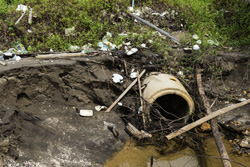Faster analysis of polluted soil and groundwater
Investigating contaminated sites has traditionally involved the drilling of vertical holes through the soil profile and collecting samples for analysis. This technique is both time consuming and expensive, and additional data requires new boreholes. These drawbacks were addressed by an EU-funded initiative that has developed an advanced in situ technique. The 'Methodology for fast and reliable investigation and characterization of contaminated sites' (MICCS)(opens in new window) project developed a more advanced method for identifying contaminants that was both fast and dependable. Researchers used new probe technology with highly sensitive volatile organic components and combined them with improved ground-penetrating radar (GPR) techniques. MICCS' probe system was designed for use in fast sonic drilling, which required an innovative high-tech design that protects components in the sensor probe. The probes can be used for collecting soil samples or direct physical/geotechnical investigation, or for collecting samples of porous air through membranes placed on the probe. Sensor measurements and the GPR provided more accurate and faster online data for polluted sites compared to the conventional method of drilling. Project partners also developed software for controlling the MICCS probe, logging results, visualising the online sensor results on screen and calculating concentrations of pollutants. The combined data collated and processed using the MICSS system can be used to draw a more precise picture of the contaminated site as a whole. This is thanks to the sensor measurements, which provide more precise data input through chemometric analysis, giving a sound basis for better decision making. Furthermore, the investigation method is easier and quicker to use than current investigation methods, hence it is more cost effective. Therefore, MICCS outcomes will help protect the natural environment and human health and well-being through a speedier and cheaper implementation of remediation techniques.







